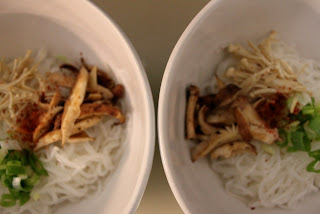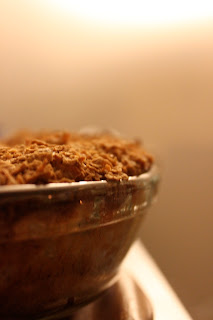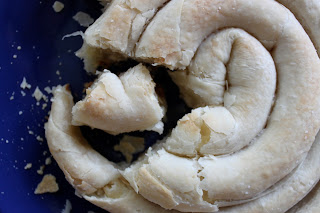Coconut-Peanut Dipping Sauce with Cucumbers
Fried Tofu Squares (to also dip in the Peanut Sauce)
Vegetable Soup with Noodles and Hot Chili Powder
Wontons
Asian food is a new direction for The Piccolo Gourmet. It's not that we don't like this type of food—we just never think to make it, really. And yes, I will be honest, it intimidates me a little. "Stick with what you know", I told myself, "And stick to items with which you are comfortable". The majority of our education and experience has been with Western European cuisine, so why stray from the path? Let's try to make something cross-cultural—fusion—as people like to call it. And that is exactly what we did.
Wonton wrappers: Cute, slimy, fun. You can fill wontons with whatever you like, which is the best part of making your own dumplings. I filled ours with Neufchâtel, minced asparagus, yellow peppers, and a touch of pimentón. Other combinations that I had in my head were: goat cheese with pears, pimientos de pardron with manchego, fava (or white bean) puree with sea salt and herbs. I know, I know, the only Asian ingredient I used were wonton wrappers. But hey, use what you are comfortable with, right?
I was cooking with friends and Jennifer, who is Korean, taught me that before I bake my wontons (which was what I did) to steam them first. Truth: My wontons came out kind of too crunchy, but not entirely inedible. (We did eat them all.) The steaming would have absolutely helped—great to know for next time—and, yes, there will be a next time.
MATERIALS:
4 oz Neufchâtel
1 cup Minced vegetables of your choice
1 heavy pinch of sea salt
1 dash of pimentón or smoked paprika
1 dash of dried thyme, oregano, garlic, or a mix of all three
1 pkg wonton wrappers
TECHNIQUE
1. Mix all your ingredients together
2. Dip entire wonton wrapper in water and cup this in your hand
3. Drop a small spoon of cheese mixture in the center of the wonton
4. Fold in edges and pinch together
5. Steam these for little bit (not sure how long Jennifer would recommend)
6. Bake in a preheated 350C oven on a greased sheet until golden on the edges, about 20 minutes.
7. EAT!!
The dinner was a full Asian-themed meal that we all shared family-style. We had Baked Vegetable-Cheese Wontons (obviously), Coconut-Peanut dipping sauce alongside Fried Tofu Squares and sliced Cucumbers, Spicy Vegetarian Noodle Soup, and Dessert Wontons that were stuffed with Nutella and Banana. Hmmm... on second thought, this might become a catagory in the future for the Piccolo Gourmet: Themed-Cooking with Friends. I guess you will have to check back in the future!





































